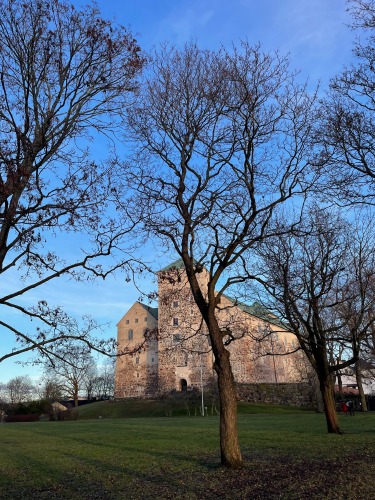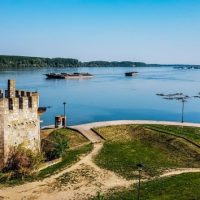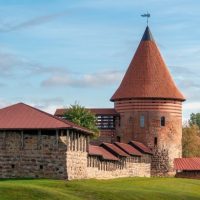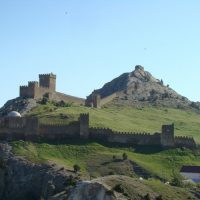Finland is not a land that is typically associated with beautiful castles.
In fact, when most of us picture Finland, we think of lush, green forests and picturesque rural views.
While castles may seem like something out of a fairy tale, they have actually played a major role in this nation’s proud history.
If you are someone who loves spending time at these historical landmarks, Finland is the perfect place to visit.
Let’s take a closer look at some of these beautiful castles so that you can learn more about these awesome attractions.
Contents
St. Olaf’s Castle
This three castle was constructed back in the 15th century and is also known as Olavinlinna.
The medieval stone fortress is positioned in Savonlinna, Finland.
Visitors will be happy to learn that there are a number of exhibitions that take place here.
The Orthodox Museum provides visitors with the chance to check out various objects sourced from Finland and Russia.
Meanwhile, the Castle Museum showcases artifacts within the palace.
Lovers of music can visit each summer and take in the Savonlinna Opera Festival as well.
This structure still stands tall on the island of Kyrönsalmi strait, serving as a connection between the Haukivesi and Pihlajavesi lakes.
Turku Castle
Located on the shore of Lake Aura in the city of Turku, Turku Castle is the largest medieval landmark that the nation has to offer.
The palace is among the oldest of its kind in Finland and is the nation’s largest surviving medieval complex.
The box-like fort features Renaissance and medieval architecture, with the construction that commenced back in 1280.
The fully restored castle is now open to the general public, as the Turku Historical Museum serves as a primary attraction.
Banquets, events, and conferences are often held at this castle, with plenty of rooms available for rent.
Visitors are also more than welcome to dine at the on-site restaurant and there is also an open cathedral.
Häme Castle
This castle was originally designed to serve as a military fortress.
From there, Häme Castle became an administrative center and a royal castle.
Others may know this castle by its other name: Tavastia Castle.
Häme once stood on a small island in Lake Vanajavesi, but the topography has since changed.
Now, the island is no more and the castle is positioned on the lake’s coast.
The 15th-century King’s Hall and Queen’s Chamber has also been restored, providing visitors with the chance to check out a guided tour.
This castle has been standing for over 700 years and has a fascinating history.
Medieval history buffs will often make a pit stop at this castle during their trips to Finland.
Suomenlinna Fortress
Suomenlinna Fortress is located roughly 2.5 miles outside of the capital city of Helsinki.
The area consists of eight islands, providing a wide range of incredible views.
The fortress was once named Sveaborg, which means “Castle of the Swedes”.
In 1918, in a patriotic gesture, the castle was renamed Suomenlinna, meaning “Castle of Finland”.
Now, the castle is known as a UNESCO World Heritage Site and is a popular destination for tourists.
Finnish locals also love this location and it is easy to see why.
Many visitors and residents will take the short ferry ride from Helsinki so that they can have picnic lunches on the fortress grounds.
The Suomenlinna Museum also remains open all year round, providing a closer look at the castle’s evolution over the years.
Fortress of Lappeenranta
This castle is especially fun, as it provides visitors and residents with the chance to enjoy a city within a city.
Locals refer to it as the “old city” and there is no shortage of restaurants, museums, and shops to visit.
Finland’s oldest Russian Orthodox Church is also located here.
Those who wish to learn about the rich culture of Russia, Finland, and Sweden are urged to visit this fortress.
This structure is situated in the town of Lappeenranta, on Lake Saimaa’s banks, nestled within the South Karelia region.
Since it is perfectly tucked between the east and the west, it was constructed as a means of blocking Northwestern Russia attacks.
History enthusiasts flock from around the world to see this landmark and it is especially popular during the summer months, due to its combination of local and historical cultures.
Kastelholm Castle
This medieval castle was originally constructed by the Swedish.
To get there, visitors must travel 25 kilometers northeast of Mariehamn.
Kastelholm is one of the five Finnish medieval fortresses that have managed to survive since the 14th century.
After its original construction on a small island, it served as a way for Swedish authority to remain consolidated across the Baltic over the course of its history.
The 1599 civil war left the castle damaged and it was eventually rebuilt in 1631.
In 1745, it was gutted and ruined.
Since then, it was restored once again and now serves as a Finnish tourist attraction.
Visitors can take a closer look at the castle’s ruins and the Karlsgården Open-Air Museum provides more background on life in the 19th century.
Oulu Castle
Located in the outlying town of Oulu and positioned at the Oulu River mouth, this castle served as a stronghold to protect against the attacks of invaders.
The original castle was destroyed in 1605 and was reconstructed on the orders of King Charles IX.
The new structure was significantly damaged by the Russians during the Great Northern War.
Since the castle’s initial destruction, wooden structures have been added, so that an observatory could be housed.
Visitors now have the chance to check out these remains in person.
There is also an exhibition that showcases the history of the castle over the course of centuries.
An on-site cafeteria caters to the needs of hungry visitors.
Raseborg Castle
These ruins are located in the town of Raseborg.
The site first came to prominence in 1378 as a Livonian Order castle.
The history of this structure is fascinating, as it was constructed over the course of centuries in three distinct phases.
The Swedes once ruled over this castle and it was even once the property of pirates.
As the sea levels began to lower, Raseborg became less relevant.
In 1553, this fortress was abandoned in favor of Helenski Castle.
In the 1890s, a rebuilding project took place after the castle had sat dormant for hundreds of years.
Visitors can only stop by during the summer months but they do have the option of exploring on their own or with a tour guide.
Bomarsund Fortress
In 1832, when Åland belonged to Czarist Russia, this fortress was constructed.
Initially, the castle was meant to serve as a means of providing the Russian czar with a powerful military presence.
Over time, the castle’s purposes would evolve. In 1854, all of that would change after the Battle of Bomarsund.
This battle, which took place during the Crimean War, resulted in the destruction of the fortress.
The castle was never rebuilt and it remains in ruins to this day.
That has not stopped visitors from flocking to this location.
The nearby museum offers visitors and residents alike the chance to learn more about the Crimean War and the route that was taken to restore peace to this nation.
Kuusisto Castle
While there is not much left of this castle other than the exterior walls, Kuusisto Castle once stood tall and proud during the Middle Ages.
During this time period, it was considered to be one of the premier castles in the world, with a number of amenities that had been sourced from overseas.
Once it was no longer utilized as a military stronghold, it became a home for Finnish Catholic Bishops.
From there, it became a centerpiece of spiritual life in the region.
Its golden era took place during the 1400s when it wielded a sizable amount of political power.
The castle was eventually destroyed, as King Gustav Vasa called for it to be razed during the Reformation.
It is open for visitors around the clock during the present day, though.
Finland Safety Overview
READ THE FULL REPORT: Finland Safety Review
Safety Index:
- OVERALL RISK: LOW
- TRANSPORT & TAXIS RISK: LOW
- PICKPOCKETS RISK: LOW
- NATURAL DISASTERS RISK: LOW
- MUGGING RISK: LOW
- TERRORISM RISK: LOW
- SCAMS RISK: LOW
- WOMEN TRAVELERS RISK: LOW
Frequently Asked Questions
Why Are So Few Finnish Castles Aristocratic or Royal?
When it comes to castles, most of us will associate them with the royals and/or aristocrats of their designated time period.
That’s why so many people find themselves wondering why there are so few Finnish castles that can be attributed to either group.
The answers become apparent when you take a closer look at the nation’s social and political history.
The majority of this nation’s castles were constructed to serve as defensive and administrative centers.
Does St. Olaf’s Castle Really Have Ghosts?
This is one of the most commonly recited legends about Finnish castles and it is easy to see why visitors would want to know.
The story of the Finnish maiden who was betrayed by the Russian soldier she was in love with is a key piece of Finnish folklore.
She was put to death for treason after she opened the castle walls for him and his fellow soldiers launched an attack.
A rowan tree was planted at her burial site and white flowers bloomed from it, indicating her innocence.
Perhaps you will run into her during a visit!
How Many of These Castles Have Been Restored?
There are a number of castles from the aforementioned time periods that have been demolished but a number of them have also been restored.
Of the castles and fortresses that were constructed during the 13th century and onward, Turku, Häme, and Olavinlinna are the most significant castles that have been restored to their former glory.
Savitaipale’s Hamina, Lappeenranta, and Kärnäkoski Fortresses have been restored as well, in addition to Suomenlinna, which is located in an archipelago adjacent to Helsinki.
When Did Castles Stop Serving as Primary Bastions?
While these castles served as a primary bastion of defense from the 13th century to the 16th century, their importance from a military standpoint started to wane as time went on.
By the time the 18th century rolled around, many of these castles were no longer used for these purposes.
In the middle of the 19th century, most of these locations became historical monuments and have maintained these designations in the present day.












Finland is not typically associated with beautiful castles, but it is home to a number of stunning and historically significant fortresses that are worth visiting.
Finland is not typically known for its castles, but these beautiful and historic landmarks are definitely worth a visit.
I find it fascinating how these castles have played such an important role in Finland’s history and continue to attract visitors from all over the world.